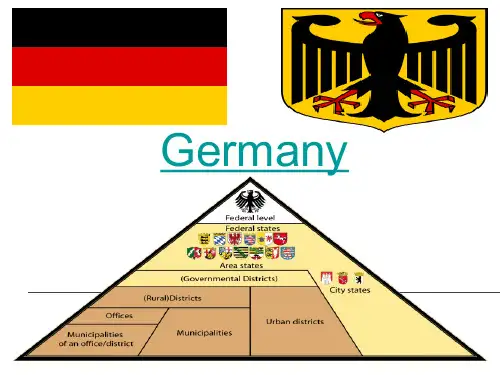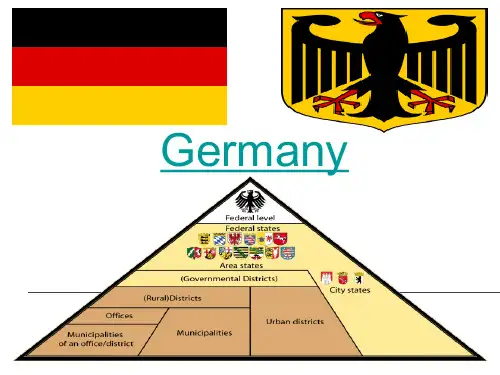英文介绍德国PPT
- 格式:ppt
- 大小:17.89 MB
- 文档页数:25











Standard of livingGermany is one of the countries with the highest standard of liv-ing in the world. According to the UN’s HDI Index, Germany is one of the most developed countries in the world in terms of life expectancy, degree of literacy and per-capita income. Thehealthcare system enables com-prehensive medical care, where-by the social security systems of the statutory health insur-ances, care and accidentinsurance and unemployment support protect people against existential risks.By Rainer GeißlerGerman society is a modern,open-minded society: Most people – both young and old – are well-educated and enjoy a high standard of living , as well as sufficient freedom to be able to plan their lives as they themselves see fit. The nucle-us of their lives is the family, which is constantly adopting new forms. Yet society is faced with the challenge of solving important problems such as population trends – the ageing of society as well as immigration, which is increasingly var-ied in terms of ethnic culture. And there is one thing the Ger-mans still have to overcome: the effects of the 45 years dur-ing which the country was divided. In the 15 years since political reunification in 1990 much has happened, and yet restoring the social unity of Germany will remain an impor-tant issue for the foreseeable future.PopulationWith reunification Germany became the country with by far the largest population in the European Union. Almost 83 million people live on German territory, almost one fifth of them in what was formerly East Germany. Three trends are characteristic of demographic developments in Ger-many: a low birth rate, increasing life expectancy and an ageing society.For 30 years now Germany has been witnessing fewbirths: With slight fluctuations, since 1975 the number of newborn infants has been approximately 1.4 children perGerman society – modern, pluralist and open-mindedCross-generational contractThis is the name of the system used to finance statutory pension insurance: employees today pay proportional contributions toward the pensions of the gen-eration of retirees in the expecta-tion that the coming generation will then pay for their pensions. The first mandatory regulations on old-age security were made as long ago as 1889. Today about80 percent of employed persons pay into the statutory pension system. Alongside contributions by the employers and employees, today the system is also funded by government subsidies. Since 2002, statutory pensions have been supplemented by state-sup-ported, private capital-backed old-age provisions.Ways of lifeThere are many different ways of life in Germany, but most peo-ple, or almost 68 million, live in multi-person households. Morethan 43 million of them live as parent/child group combina-tions, and these include just under 21 million children. Justshort of 23 million people live as couple, and yet close to14 million live alone.Single parentsIn more than 90 percent of the 1.5-million plus families in which a single parent brings up the chil-dren, that person is the mother .The family continues to be the key social institutionTrend to more part-time work part-time employment are women –mostly mothers – who do 85 percent of all such jobs. This results in average weekly working hours for men of over 40hours, and for women of only just 31 hoursHome ownershipSportUpbringing Social causesL i v i n gM o b i l i t yF o o d263L e i s u r e t i m e261The most popularleisure time activities Home owners and tenants (in percent)The three largest areas of voluntary service TNS InfratestStatistisches BundesamtStatistisches BundesamtStatistisches BundesamtStatistisches BundesamtT e n a n t s57.8H o m e o w n e r s42.2Tennis 1.8Gymnastics Soccer Shooting1.5The most popular types of sport (in million members)Athletics 0.9Sport Going out DIY/gardening Relaxing at home Cinema Culture High proportion of women in GFKS a l a r i e d s t a f fW o r k e r s31.3C i v i l s e r v a n t s 6.3S e l f -e m p l o y e d 10.8Top jobsWomen account for some 21 per-cent of leading executives in Ger-many, and every third manager is a woman. In Eastern Germany,the ratio of female to male man-agers is far more even. There a good 42 percent of managers are women and as many as 29 per-cent of the key executives are women. In Western Germany, the figures are only 32 and 20 per-cent respectively. The opportuni-ties for women to assume man-agement responsibilities depends strongly on the sector . It is high-est in the service industry, where53percent of managers are women. In the construction industry, by contrast, the figureis only 14percent.Women in the worldof work: Womennow account for 45 per-cent of all employedpersonsLife style of the elder generations Senior citizens are not only grow-ing older , but are healthier , fitter and more active than in the past.They are also economically bet-ter off: the over 60s hold almost a third of total purchasing power .The life style of the 50+ genera-tion has changed considerably,and the silver-agers increasingly prioritize active leisure time.According to an SWR study, here they emphasize nurturing social contacts. The elderly tend to meet friends almost once a week and go to a restaurant on aver-age twice a month. Alongside almost daily viewing TV (news),listening to radio (classic) and reading the paper , they like to do sports – on average five times a month.increasing life expectancy, after Japan and Italy German society has the third-largest proportion of elderly people worldwide. Their ways of life and lifestyles have changed a lot over the last decades. Nowadays the vast majority of eld-erly people lead independent lives. For the most part they live close to their children, with whom they are in close con-tact. Health-wise the “young elderly”, who are younger than 75 or 80, are mostly in a position to carry on living inde-pendent lives with new goals and actively decide how to make use of their leisure time.Financially speaking the elder generation is for themost part taken care of: The 1957 pensions reform gradual-ly gave pensioners a full share in the nation’s wealth. Today it is even possible for them to give their children financial support to start their own family. Poverty in old age has not been done away with entirely, but the risk of being poor in old age is lower than that of other age groups.Pensioners in Eastern Germany are also well off. Theyare among those who have benefited most from reunifica-tion, and are now no longer condemned to live on the periphery of society many of them were forced to inhabit in the former East Germany. Today their income is almost on a par with the Eastern German average, and satisfaction with it is considerably higher than among East Germans younger than 60.Immigration and integrationEver since the 1950s post-war boom the German economy has been dependent on immigrant workers. The majority of those who were at the time referred to as “guest workers”have now returned to their home countries in South and Southeast Europe, but many have stayed on in Germany to earn their keep. Many of the Turkish immigrants that came to Germany at a later date have also remained in the coun-try. This has resulted in Germany gradually developing from a country that accommodated guest workers to a country with regulated immigration.but also with democracy: The pessimistic protest and “can’t be bothered” attitude of the 1980s has for the most part given way to a non-ideological, optimistic pragmatism.Today’s young generation is success-oriented and prepared to work hard. Their maxim of life can be reduced to the for-mula “getting on instead of getting out”.With regard to the traditional left-wing/right-wingdivide, today’s youth is typically positioned somewhat to the left of the population as a whole; only very occasionally are there instances of political extremism. On the other hand there is a high degree of willingness to get involved with social commitment . Some three-quarters of all youngsters are actively committed to social and ecological interests: elder-ly people in need of help, environment and animal protec-tion, the poor, immigrants and the disabled. Interest in pol-itics, political parties and trade unions, on the other hand,is on the decline. Only about 30 percent of 12 to 25-year old youngsters claim to be at all interested in politics, whereas among young adults and students the figure is considerable higher, namely 44 and 64 percent respectively.The elderlyIn Germany, approximately every fourth person is over 60years old. Because of the long-standing low birth rates andSocial commitmentSocial commitment amongyoung people in Germany is grat-ifyingly high. Indeed, 37 percent of the young people in the 14-24year age bracket do voluntary work. They are active on behalf of sports, leisure time, school,cultural and church affairs or in the emergency services. The proportion of young people in some areas is so high that with-out their commitment the ser-vices would collapse – for exam-ple in the field of sports. Half of all young people are members ofclubs, a quarter dedicated to large social organizations, espe-cially to the churches.Young people: Helping others is a self-evidentpart of their lives4.1 1974 4.419847.1 19947.3Foreign populationin millionsStatistisches Bundesamt0.71961Immigration lawIn early 2005 the first Immigra-tion Act in German historycame into force. It distinguishes between limited residence per-mits and unlimited right of residence. At the same time, it also lays down measures to inte-grate immigrants, such as mandatory language courses.Among the foreigners, some 1.8 million persons with Turk-ish citizenship form the largest group. There are also signif-icant numbers of Italians (550,000), immigrants from Serbia-Montenegro (a good 500,000), Greeks (320,000) and Poles (almost 300,000), followed by Croats, Russians, Bosnians,Ukrainians, Portuguese and Spaniards. More than one mil-lion people are refugees.Because Germany specifically recruited a labor forcefor simple activities, many of the immigrant workers are employed as unskilled laborers. Some work as skilled labor-ers but only very few in professions that require high quali-fications. Studies have revealed that immigrant families in Germany find it particularly difficult to improve their social standing and economic position.Nonetheless, over the past decades progress has beenmade with regard to the integration of immigrants: Acquir-ing German citizenship has also been facilitated, contacts between immigrants and Germans are closer, and there is more widespread acceptance of ethnic cultural variety. And the new im m igration law provides for the first time an all-embracing legal framework that considers all aspects of immigration policy – from labor market-oriented and humanitarian immigration through to questions of integra-tion. And yet integration remains a challenge for politicians and society alike. Efforts now focus on improving German language skills, providing enhanced educational opportuni-ties for immigrant children, and measures to prevent dualsocieties and ethnic ghettoes.•Repatriates of German descent, who for generations have been living in the states of the former Soviet Union, Roma-nia and Poland, are a second major group of immigrants.Since the collapse of the communist systems they have been returning to Germany in increasing numbers.These two groups of immigrants resulted in the percapita rate of immigration to Germany in the 1980s being con-siderably higher than that of classic immigration countries such as the USA, Canada and Australia. There are more than seven million foreigners, in other words almost nine percent of the population, living in Germany. In addition there are also 1.5 million foreigners who have taken German citizen-ship, and some 4.5 million repatriates. This means that almost every sixth citizen has either immigrated or stems from an immigrant family. Some 95 percent of foreigners live in Western Germany and primarily in big cities, where in some cases they make up more than 30 percent of the population.ImmigrationAs early as the 19th century Ger-many attracted a large number of immigrants and since the 1950s has emerged as the Euro-pean country with the largest immigrant population. In 1950,there were about 500,000 foreigners in Germany, account-ing for a mere one percent or so of the population. This has changed emphatically: Today,some 7.3 million foreigners live in Germany, or 8.8 percent of the population, including 2.3 million EU citizens. About every fifth foreigner living in Germany wasborn here and is a second or third-generation immigrant.Rainer GeißlerProfessor of Sociology at Siegen University, Geißler is the author of the standard sociology textbook ”Die Sozialstruktur Deutschlands“.the other half Protestants. The new German Ethno-cultural diversity:About every sixth inhabitant is an immigrant or a member of a family of immigrantsLong-term care insuranceLong-term care insurance was introduced in 1995 as the “fifth column” of the social insurance system. The compulsory insur-ance is financed by equal contri-butions by employers and employees. There are plans to extend this financing through provisions covered by capital.financed in the long term: The increasing proportion of eld-erly people in the population in conjunction with a rela-tively low birth rate and trends in the labor market have pushed the social security system to its very limits. By means of extensive reforms politicians are now busy attempting to meet this challenge and ensure a welfare system based on solidarity for coming generations as well.Reform of the health systemGermany is one of the countries with the best medical care.A wide range of hospitals, medical practices and institutions guarantees medical care for everybody. With over four mil-lion jobs, health care is the largest employment sector in Ger-many. All in all, 11.1 percent of the country’s gross domestic product is spent on health – 2.5 percent more than the aver-age in the OECD member countries. As a result of the so-called cost-cutting law introduced in the wake of the reformSocial securityAffluence for everybody and social justice: In the late 1950s that was the goal the then Federal Minister of Eco-nomics Ludwig Erhard had in mind when he introduced the social market economy in Germany. The “German model”proved to be a success story and became an archetype for several other countries. One of the pillars of this success was the extensive German welfare system. Today, Germany boasts one of the most comprehensive welfare systems: 27.4percent of the country’s gross domestic product is chan-neled into public welfare spending. In comparison, the USA invests 14.7 percent, while the OECD average is 20.4 percent.An all-embracing system of health, pension, accident, long-term care, and unem ploym ent insurance provides protection against the financial consequences of the risks we face in everyday life. In addition, the welfare lifeline offers tax-financed services such as the family services equalization scheme (child benefit, tax concessions) or basic provisions for pensioners and those unable to work. Germany sees itself as a welfare state that considers the social protection of all its citizens to be a priority.The welfare-state social systems in Germany have along tradition dating back to the industrial revolution. In the late 19th century, Reich Chancellor Otto von Bismarck devised the principles of the state social insurance scheme;It was under his aegis that the laws relating to accident and health insurance as well as provisions for invalidity and old age were passed. Whereas in those days a mere ten percent of the population benefited from the welfare legislation,nowadays almost 90 percent of people in Germany enjoy its protection.In subsequent decades the welfare lifeline wasexpanded and refined; in 1927, for example, insurance cov-ering the financial consequences of unemployment and, in 1995, long-term care insurance were introduced. The 21st cen-tury calls for a fundamental structural realignment to the systems, in particular with regard to whether they can beUnemployment insuranceIn Germany those with no work can claim support. Anyone who is unemployed and over the past three years has paid contribu-tions to the state unemploymentinsurance system for at leasttwelve months is entitledto unemployment benefit (60 to67 percent of their last net income). This unemployment benefit is financed through the contributions of which employersand employees each pay half.The longest period for which unemployment benefit can be drawn is twelve months and 18 months for those aged 55 or over . After that period those looking for work can apply for basic support (known as “unem-ployment benefit II ”), which is assessed according to the appli-cant’s needs.The welfare stateThe principle of the welfare state is enshrined in Article 20 of the Basic Law and cannot be rescind-ed, even if the Basic Law is changed. In this way the Basic Law commits the state to pro-tect, in addition to their freedom,the natural bases of life of its citi-zens. Each individual, however ,also has to assume responsibilityfor his own social welfare.are plans to replace the current child-raisingPension insuranceThe statutory pension insurance is the most important pillar of old-age provisions. Its financing is split: The monthly contribu-tions paid by employees and employers pay the pensions of those currently in retirement.Through their contributions,those insured acquire some rights when they themselves become pensioners. In turn, com-ing generations provide for these future rents with their contribu-tions (cross-generational con-tract). In addition, company and private pensions are thesecond and third pillars of provi-sions for old age. Under certain conditions these also enjoy gov-ernment support.ple’s insurance” (SPD). The government plans to present a feasible solution to this complex question in 2006.Pension reformFundamental changes are also planned for provisions in old age. Although compulsory pension insurance will remain the single most important pillar of income in old age, in-com-pany and private pension schemes are becoming more and more important. The so-called “Riester pension”, named after former Minister of Social Affairs Walter Riester, is one such model already in existence that by means of tax con-cessions makes possible private pension schemes covered by capital contributions. For reasons of justice between gener-ations, the pensions to which the current generation of pen-sioners is entitled are not being increased.The government has also resolved to raise the age ofretirement from 65 to 67: Between 2012 and 2035 it will be raised one month every year. At the same time an incentive scheme known as “Initiative 50 Plus” is geared to improving opportunities for older employees.Further reformsThe reform of support for the long-term unemployed and those receiving social assistance has already been imple-mented. With the introduction of basic support for the unemployed those who had formerly been receiving social security, as long as they were capable of working, were put on a par with the long-term unemployed. The reform of the accident insurance scheme, aimed primarily at reforming theorganizational framework, is still outstanding.•already undertaken to the health system, Germany now makes the lowest per capita increase to health spending of all OECD countries: Between 1998 and 2003 spending rose in real terms by 3.8 percent per annum, while the OECD mean was 4.5 percent.Yet in order to ensure that spending is adapted to thealtered conditions there is still a need for further reform. As such the grand coalition is striving for a fundamental struc-tural reform of the health system and also to make the health insurance systems fit for the future. To this end the coalition parties in government have devised different concepts,which, however, are not necessarily compatible: the “soli-darity system health premium” (CDU and CSU) and the “peo-Health insuranceAlmost all citizens in Germany have health insurance, whetheras a compulsory member of the statutory health insurance scheme (88 percent) or a private health insurance scheme (almost 12 percent). The health insurancecompanies cover the cost of medical treatment, medication,hospitalization and preventive health care. Contributions to thehealth insurance scheme are made by employees and employ-ers. Non-employed family mem-bers of those in a compulsory health insurance scheme do notpay any contributions.Accident insuranceStatutory accident insurance is aliability insurance on the part of employers in favor of employ-ees who are thereby protectedfrom the consequences of an accident at work or an occu-pational disease.Social assistanceAnother feature of the social lifeline is social assistance, which is financed through taxes. It comes into effect when people are unable to escape their plight on their own and by their own means or by those of relatives.As such, there is basic protection in old age or in the case of long-term unemployment as well as state help towards living or to assist persons in certain predica-ments.High standards: Germany is one of the countries withthe best medical care。
英语介绍德国Germany, officially known as the Federal Republic of Germany, is a country located in Central Europe. It is bordered by nine countries, including Denmark to the north, Poland and the Czech Republic to the east, Austria and Switzerland to the south, and France, Luxembourg, Belgium, and the Netherlands to the west.With a population of over 83 million people, Germany is the most populous country in the European Union. Its capital and largest city is Berlin. German is the official language of the country.Germany is renowned for its rich history, culture, and contributions to various fields such as science, technology, literature, philosophy, and music. It has been the birthplace of influential figures like Johann Wolfgang von Goethe, Ludwig van Beethoven, Albert Einstein, and Karl Marx.The country is also famous for its engineering and automotive industries, with companies like Volkswagen, BMW, and Mercedes-Benz producing high-quality vehicles that are exported worldwide. German engineering is synonymous with precision, efficiency, and innovation.Germany is known for its efficient public transportation system, including an extensive network of trains, trams, and buses. The Autobahn, Germany's highway system, is famous for sections with no speed limits.German cuisine offers a diverse range of dishes, with regional specialties like bratwurst, sauerkraut, pretzels, and Black Forest cake. Beer is an integral part of the culture, and Germany is famous for its beer festivals such as Oktoberfest.The country is also renowned for its picturesque landscapes, from the majestic Alps in the south to the scenic Rhine Valley and the Baltic Sea coastline in the north. Germany offers numerous opportunities for outdoor activities like hiking, skiing, and cycling.In terms of governance, Germany is a federal parliamentary republic, with the President serving as the head of state and the Chancellor as the head of government.Overall, Germany is a vibrant and culturally rich country that combines a strong industrial base with a deep appreciation for art, history, and nature. It continues to be a prominent player on the global stage in various fields and attracts millions of visitors each year.。